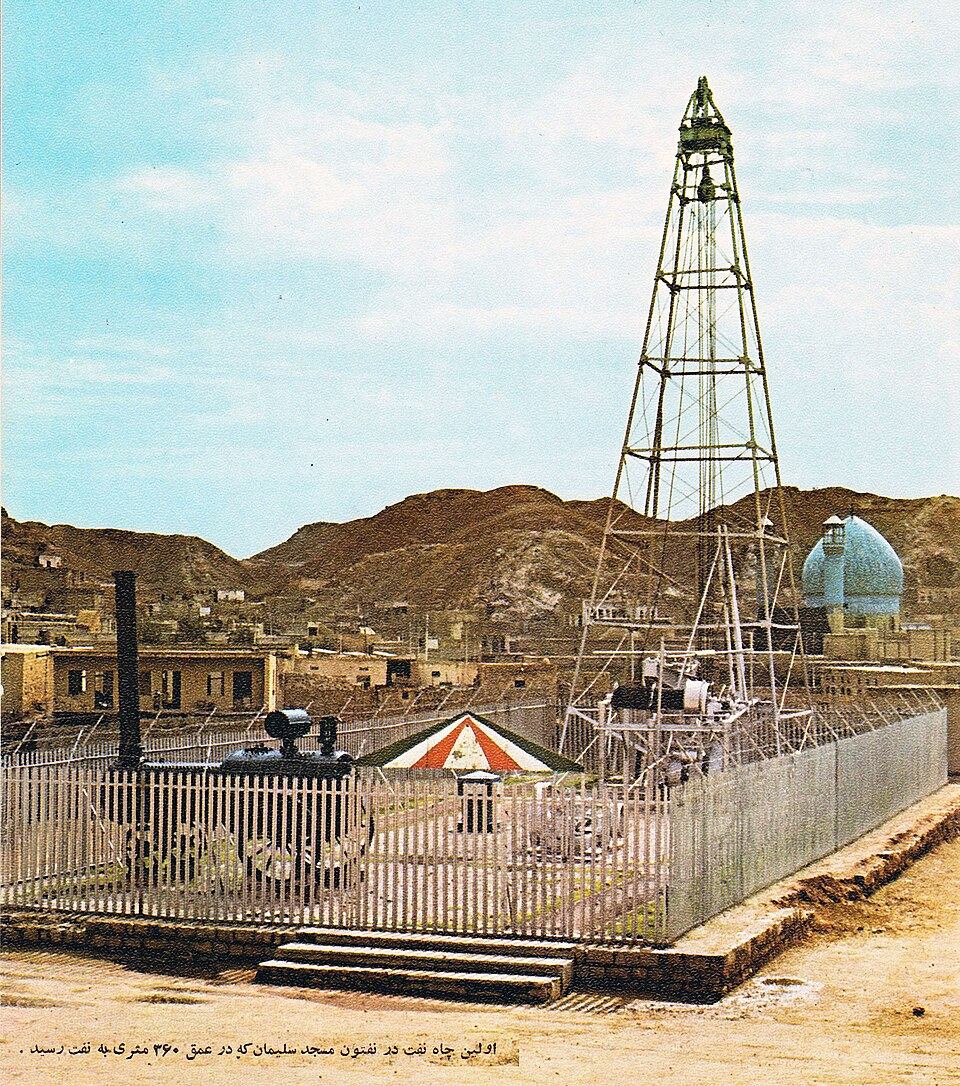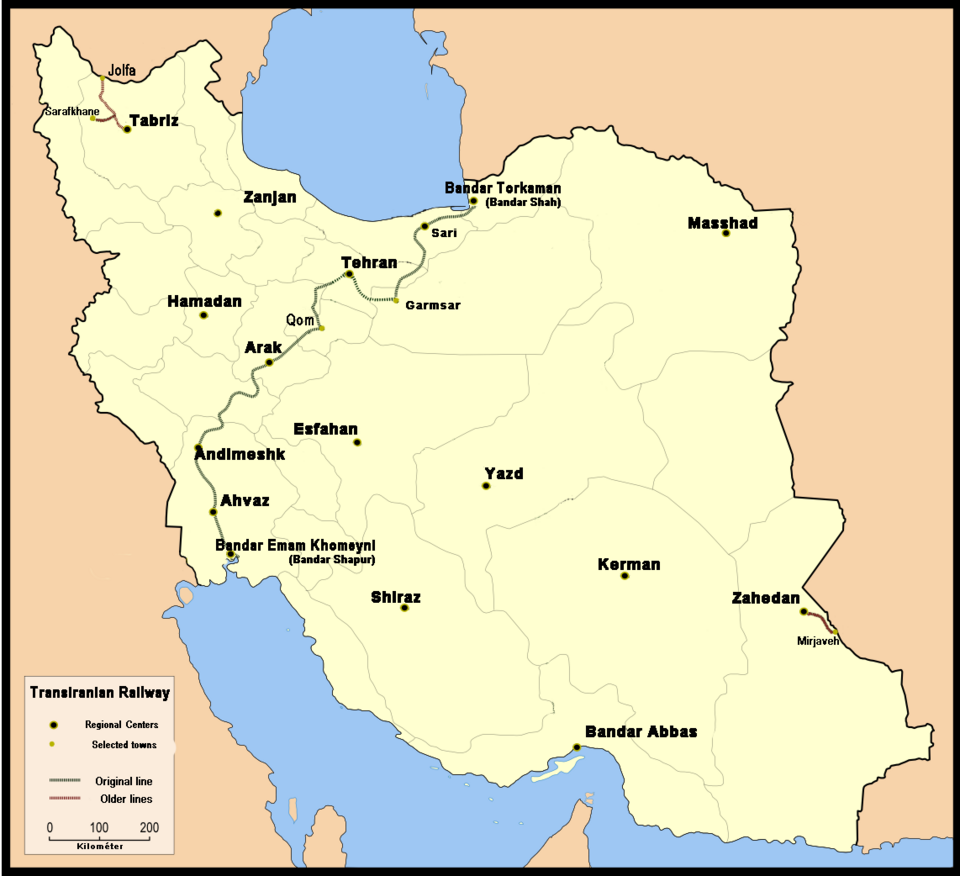IB Syllabus focus:
'Select one of these regions for a case study, covering economic, political, and social developments, western influences, and attempts at modernization within the chosen area.'
Iran during the early 20th century is a vivid tapestry of socio-economic evolution, political upheaval, and cultural renaissance, as it sought to modernise while retaining its unique identity amidst Western encroachment.
Economic Developments
The Discovery of Oil
1908: The discovery of oil revolutionised Iran's economy. The Anglo-Persian Oil Company (APOC), which became British Petroleum, controlled oil extraction and exportation.

The first successful oil well at Masjed-e Soleyman (Well No. 1), whose 1908 strike launched Iran’s modern oil industry and paved the way for APOC’s dominance. The image underscores how foreign control over extraction shaped early revenue flows and nationalist responses. Source
Oil Revenues: These created a new economic sector, yet benefits were skewed towards the British, fostering nationalistic resentment.
World War I Impact
Despite neutrality, Iran suffered occupation by Russian and British forces, disrupting trade and causing famine.
Post-war recovery was marred by economic instability and reliance on foreign aid.
Industrialisation
1930s: Efforts to diminish reliance on oil led to the establishment of textile factories, sugar refineries, and other manufacturing units.
Political Developments
Constitutional Revolution Aftermath
1911: Russia's intervention quashed constitutionalists, leading to a power vacuum and political instability.
Reza Shah's rise was partly a reaction to this instability and foreign interference.
Reign of Reza Shah Pahlavi
1925-1941: Reza Shah Pahlavi centralised power, curtailed the influence of religious authorities, and pursued a nationalist agenda.
His regime tackled corruption, streamlined administration, and enforced state control over the economy.
Foreign Relations
The Anglo-Persian Agreement of 1919 nearly made Iran a British protectorate, sparking intense nationalistic backlash.
1935: The official renaming to 'Iran' was a gesture to reflect a new national identity.
During WWII, Iran declared neutrality but was invaded by the Allies in 1941, highlighting its strategic importance and vulnerability.
Social Developments
Education Reforms
Expansion of state education reduced illiteracy from about 80% to lower levels, although exact figures are contested.
Western educational models inspired the curriculum, focusing on sciences and humanities.
Women's Emancipation
Reza Shah's reforms encouraged women's education and discouraged traditional dress, sparking both support and opposition.
Public Health
Public health campaigns, including vaccination programs, improved general health.
Establishment of the University of Tehran in 1934 fostered medical research and training.
Western Influences
Economic Inroads
APOC's monopoly and subsequent Western economic foothold became symbols of foreign control, leading to nationalisation calls.
Western business practices and management techniques began influencing Iranian enterprises.
Political Repercussions
Western military advisors shaped Iran’s armed forces, which some saw as diminishing Iran's sovereignty.
Legal and governmental reforms were modelled on European systems, aiming to modernise but also challenging traditional structures.
Cultural Exchange
Western literature, cinema, and fashion became increasingly popular among urban Iranians, often associated with modernity.
Attempts at Modernisation
Governance and Legal System
A new civil code and penal code, inspired by European systems, were implemented.
The establishment of modern bureaucracy aimed at efficient administration.
Military Reforms
The creation of a modern, conscripted military was influenced by European doctrines and command structures.
Reza Shah's regime procured modern weaponry and built military infrastructure with Western help.
Economic Strategy
The First Development Plan (1941) sought to diversify the economy, emphasising agriculture, infrastructure, and industry.
Railways, such as the Trans-Iranian Railway, symbolised progress and facilitated trade and military movement.

Map of the Trans-Iranian Railway as of 1938, showing the north–south trunk line and key junctions built under Reza Shah’s modernization program. The network connected ports to the interior, lowering transport costs and enhancing state control. Source
Cultural Policies
The Pahlavi regime promoted Persian arts, heritage, and language to forge a strong national identity.
Reza Shah's cultural reforms sought to secularise society, reducing the traditional hold of Islamic clerics.
Opposition to Modernisation
The speed and scale of reforms alienated many, especially the clergy and tribal leaders who lost influence.
Disparities grew as urban centres modernised, while rural areas remained largely untouched.
World War II and its Aftermath
Allied occupation during WWII undermined Reza Shah's authority, leading to his abdication in 1941.
Iran's strategic importance highlighted by the war led to renewed interest in its oil and geopolitical position.
In conclusion, Iran from 1914 to 1945 experienced significant transformations as it sought to assert its sovereignty and modernise in the face of Western influences. This period was pivotal in shaping the nation’s trajectory towards the mid-20th century.
FAQ
The Allied occupation during World War II had a paradoxical effect on Iran's modernisation. On the one hand, it demonstrated the country's vulnerability to foreign powers and interrupted Reza Shah's modernisation projects, leading to his abdication in 1941. On the other hand, the subsequent occupation and the need to supply the Soviet Union via Iran accelerated infrastructure development, particularly in transportation. Additionally, the occupation exposed Iran to new political ideas, such as greater democratic governance, which influenced post-war political developments. The occupation also strained Iran's economy due to the Allies' requisitioning of resources and the introduction of foreign military personnel.
The Trans-Iranian Railway, completed in the 1930s, had a transformative impact on Iran's economic and social development. It facilitated the movement of goods and people across the country, promoting internal trade and economic integration. The railway also enabled the efficient transportation of Iran's resources, particularly its oil, to ports for exportation, which was crucial for economic growth. Socially, it connected remote regions to urban centres, encouraging migration, cultural exchange, and the spread of ideas. This infrastructure project was a symbol of modernisation and national progress, though its benefits were not uniformly felt across all strata of society.
The discovery of oil turned Iran into a focal point for international power politics in the early 20th century. Initially, it led to increased British influence through the Anglo-Persian Oil Company and subsequent agreements that sought to secure British access to Iranian oil. These interactions often undermined Iran's sovereignty, provoking nationalistic reactions. During World War II, Iran's oil reserves were deemed strategically vital, leading to the Allied invasion and occupation of Iran in 1941, despite its declared neutrality. The importance of oil thus not only shaped Iran's economy but also its international relations, particularly with Great Britain and later, the Soviet Union and the United States.
Reza Shah's land reforms aimed at reducing the power of tribal chiefs and landlords to create a more centralised state. These reforms often involved the redistribution of land and the modernisation of agricultural practices. However, the implementation was not always effective or beneficial for the rural population. While some peasants received land, the lack of support in terms of agricultural extension services, finance, and infrastructure often left them struggling. Furthermore, the reforms did not break the landowning elite's power as intended; many landlords managed to retain control over their lands through political connections or by circumventing the laws. As a result, rural development was uneven and led to continued social stratification and economic disparities.
Reza Shah Pahlavi's policies significantly reduced the influence of religious authorities in Iran, as part of his secularisation efforts. His government took control of religious schools and properties, which weakened the economic power of the clerics. He enforced a dress code that banned the veil and promoted Western attire, a move that altered the social landscape and reduced the visible signs of religious life in public spaces. Reza Shah's push for a secularised, modern Iran was met with resistance from religious factions, setting the stage for future tensions between state and mosque that continued to shape Iranian society.
Practice Questions
Reza Shah Pahlavi's policies were instrumental in the modernisation of Iran, laying the foundation for a centralised secular state. His initiatives streamlined governance, reduced the influence of traditional power structures such as the clergy, and encouraged the development of infrastructure and industry. His modernisation efforts, particularly in education, the military, and the legal system, drew heavily on Western models, indicating his significant role in steering Iran towards a new national identity. Although his methods were sometimes autocratic, they undeniably pushed Iran towards modern statehood, balancing between modernisation and maintaining Iranian cultural heritage.
Western influences profoundly impacted Iran's economy, particularly after the discovery of oil by the Anglo-Persian Oil Company, which entrenched Western economic interests in the country. These influences also permeated Iranian society, with the adoption of Western educational models, legal reforms, military restructuring, and cultural exchanges such as cinema and fashion. However, these Western influences were a double-edged sword; while they contributed to modernisation and the development of infrastructure, they also generated significant internal resistance and were seen by many as a threat to Iran's sovereignty and traditional values. Thus, the impact was transformative but also contentious.

